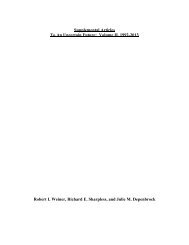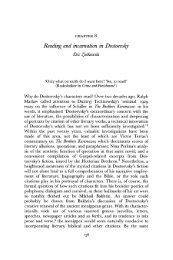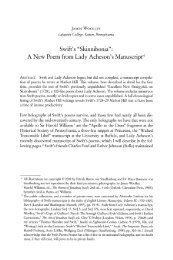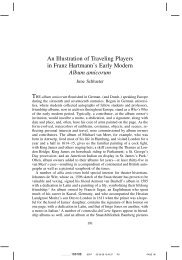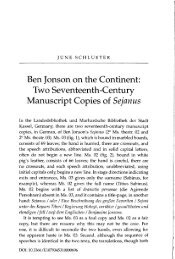courses of instruction - Lafayette College
courses of instruction - Lafayette College
courses of instruction - Lafayette College
You also want an ePaper? Increase the reach of your titles
YUMPU automatically turns print PDFs into web optimized ePapers that Google loves.
ECONOMICS AND BUSINESS<br />
cal economy, finance, applied economics,<br />
and international economics. Special<br />
opportunities include participating in re<br />
search with faculty members, internships,<br />
and the <strong>Lafayette</strong> Student Investment<br />
Research Fund.<br />
Requirements for the major: A major<br />
consists <strong>of</strong> Economics and Business 101,<br />
211, 212, 213,218 and a minimum <strong>of</strong> five<br />
department electives, at least two <strong>of</strong> which<br />
must be from the economics selections.<br />
Students must complete an appropriate<br />
Mathematics sequence, usually Mathe<br />
matics 125 and 186, or Mathematics 161<br />
and 176. The combination <strong>of</strong> Mathematics<br />
161 and 186 is not adequate for the major<br />
in Economics and Business.<br />
For information on the joint major in<br />
Mathematics and Economics, refer to p.<br />
145.<br />
For information on the coordinate ma<br />
jor in International Economics and Com<br />
merce, refer to p. 141.<br />
Additional departmental course <strong>of</strong>fer<br />
ings appear under Interim Session in this<br />
catalog.<br />
Requirements for the minor: Six <strong>courses</strong><br />
within the department, with prerequisites<br />
enforced. The following Economics and<br />
Business <strong>courses</strong> may not be used to satis<br />
fy the requirements for the Mathematics/<br />
Natural Sciences unit or the Humanities/<br />
Social Sciences unit <strong>of</strong> the Common<br />
Course <strong>of</strong> Study: Economics and Business<br />
213,218, 219, 302, 303, 304, 320, 321, 322,<br />
324,352, 365, 367-368.<br />
101. Principles <strong>of</strong> Economics. An intro<br />
duction to economics stressing the funda<br />
mental and central concepts in economics<br />
and discussing methods and topics that<br />
engage economists. Topics include supply<br />
and demand analysis, determination <strong>of</strong><br />
prices, output and pr<strong>of</strong>its, distribution <strong>of</strong><br />
income, determination <strong>of</strong> real GDP, and<br />
fiscal and monetary policy. Offered every<br />
semester. Staff<br />
<br />
210. Foundations in International Eco<br />
nomics. This course provides nonmajors<br />
with an intermediate level microeconomic<br />
and macroeconomic foundation for the<br />
study <strong>of</strong> international economics. It ad<br />
dresses trade-related issues, such as why<br />
trade exists and who gains and loses from<br />
trade. International financial concepts,<br />
such as exchange rates and the balance <strong>of</strong><br />
payments, are also examined. The course<br />
is open to nonmajors only and is designed<br />
specifically for International Affairs ma<br />
jors. International Affairs majors should<br />
take this course in the fall <strong>of</strong> sophomore<br />
year. Students who receive credit for 210<br />
may not receive credit for 211 or 212.<br />
Similarly, students who receive credit for<br />
211 or 212 may not receive credit for 210.<br />
Prerequisite: E&B 101. Offered every year.<br />
Mr. DeVault<br />
211. Intermediate Microeconomics. A<br />
study <strong>of</strong> how individuals and organiza<br />
tions deal with the problem <strong>of</strong> scarcity, the<br />
role <strong>of</strong> prices in coordinating economic ac<br />
tivity, criteria for determining desirable al<br />
location <strong>of</strong> resources, the mix <strong>of</strong> private<br />
and public institutions, and the economic<br />
basis <strong>of</strong> public policies. Prerequisites:<br />
E&B 101 and Mathematics 125 and 186 or<br />
Mathematics 161 and 176. Offered every<br />
semester. Ms. Averett, Mr. Heavey<br />
212. Intermediate Macroeconomics. An<br />
examination <strong>of</strong> aggregate economic activi<br />
ty focusing on the forces that determine<br />
the behavior <strong>of</strong> real GDP, interest rates,<br />
and the price level. Economic growth,<br />
fluctuations, unemployment, and inflation<br />
are analyzed along with alternative poli<br />
cies for dealing with them. Prerequisites:<br />
E&B 101 and Mathematics 125 and 186 or<br />
Mathematics 161 and 176. Offered every<br />
semester. Mr. DeVault, Mr. Camber<br />
213. Fundamentals <strong>of</strong> Econometrics and<br />
Business Forecasting. This course focuses<br />
on building multiple regression models<br />
useful for testing economic theories and<br />
making business forecasts. Topics include<br />
simple and multiple regression, dummy<br />
variables, multicollinearity, heteroscedas-<br />
ticity, serial correlation, and binary depen-



